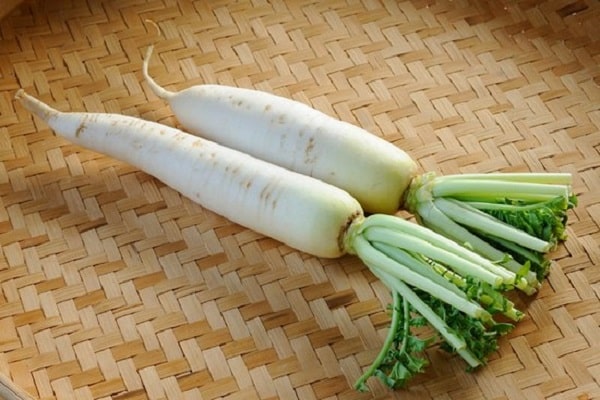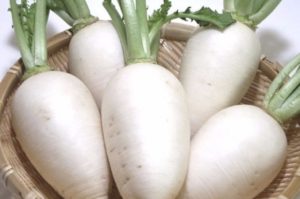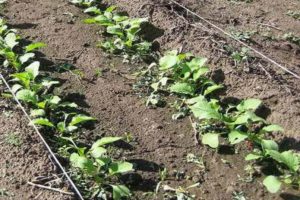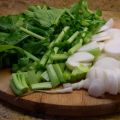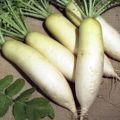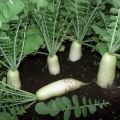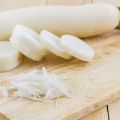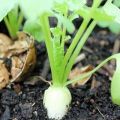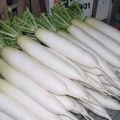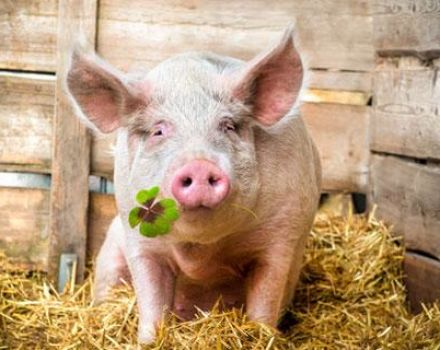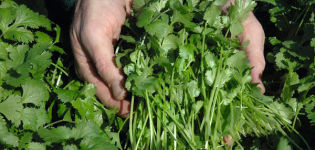Planting, growing and caring for a daikon, when to plant in open ground
The diet of people who monitor their health includes vegetables that have beneficial properties. Therefore, many gardeners are interested in complete information about the cultivation of daikon, its planting, the timing of planting and the care of the root crop that came to us from Japan.
Content
- 1 Landing in open ground
- 2 Seat selection
- 3 Soil preparation
- 4 The choice of planting material
- 5 Growing seedlings from seeds
- 6 Landing dates
- 7 When to plant before winter
- 8 Care
- 9 Watering schedule
- 10 Weeding
- 11 Top dressing and fertilization
- 12 Diseases and pests
- 13 Harvesting and storage
- 14 Daikon radish varieties
Landing in open ground
It is not difficult to grow a daikon if you know the peculiarities of this culture. Most often, many gardeners fail due to errors with the planting date and the choice of a place for growing a root crop. Having understood the intricacies of the care and planting of Japanese radish, you can grow large specimens weighing from 0.5 to 3 kg.
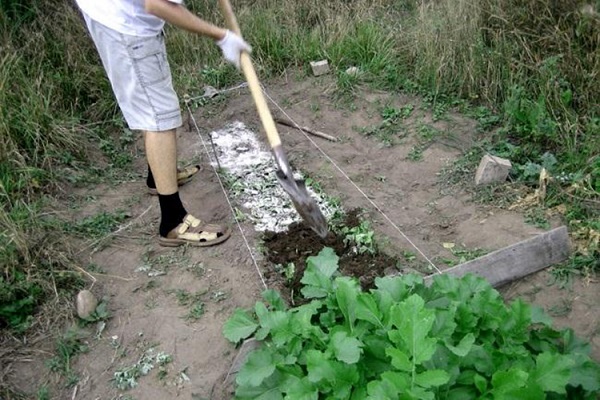
The characteristics of the root crop (weight, length, diameter, shape) depend on the variety, care and weather conditions. Radish of various varieties can grow in length from 10 to 60 cm, having a diameter of 4-8 cm. The shape directly depends on the variety. In the open field, the daikon is planted according to the schemes:
- 30 x 50 cm medium sized varieties;
- 40 x 50 cm large-fruited varieties.
The seeds are deepened by 2 cm. Before emergence, the soil is moistened from a watering can with a fine diffuser.
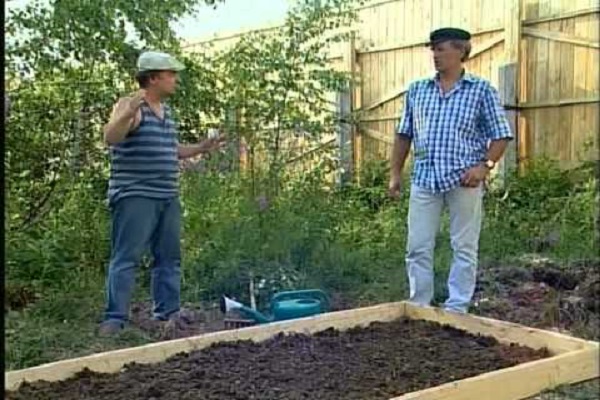
Seat selection
The choice of a place for a garden bed is a crucial moment that determines the quality and quantity of the crop. Planting a daikon in the shade (partial shade) is a gross error that will result in a large number of tops and small fruits, the shape and size of which will not match the description printed on the seed bag.
Characteristics of a plot suitable for growing large Japanese radish:
- complete absence of shade throughout the day;
- 2 years on this site were grown crops that do not belong to the Cruciferous family;
- suitable soil (light loam).
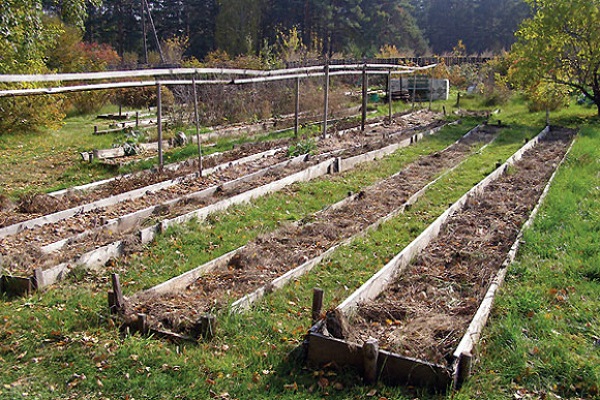
Soil preparation
Autumn is a good time to prepare the soil for spring planting. If the sowing of the daikon is planned to be carried out in the summer, then the soil is prepared in the summer after the harvest of the predecessor culture. Soil structure is important for daikon, it grows better in loose soil.
Given the possible length of the root crop (60 cm), the soil must be dug deep. If you follow the advice of experienced vegetable growers, the ridge should be prepared using the following technology:
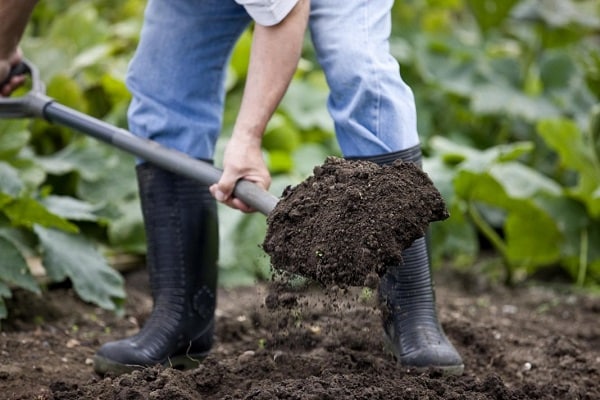
- remove the soil layer to the depth of the bayonet shovel and set it aside;
- dig up the area prepared in this way, adding humus to it;
- return the previously removed land to its original place;
- add humus at the rate of 3-4 kg / m²;
- apply mineral fertilizers (superphosphate, potassium sulfate).
It is necessary to check the soil pH level. Daikon, as a member of the Cruciferous family, prefers neutral or slightly alkaline lands.Lime is added to acidic soil once every 5 years. In the current season, ash helps to normalize the pH level, the application rate is 2 st / m². Wood ash not only deacidifies the soil, it serves as a supplier of micro and macro elements useful for daikon.
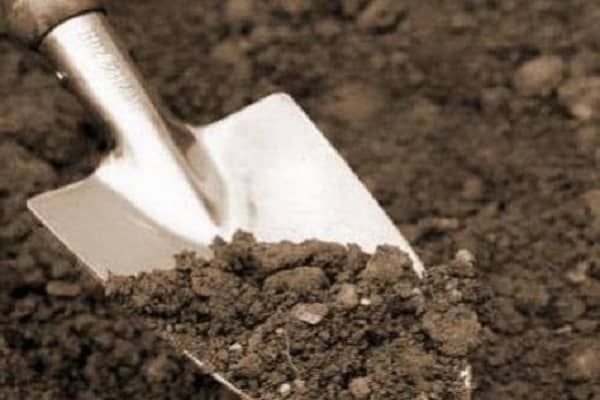
The choice of planting material
When choosing seeds for planting, you should always read the description of the variety, how to plant it, in what time frame and analyze whether it is suitable for growing in this climate. In the middle lane, early and mid-season varieties of daikon ripen. When late varieties of radish are planted, small roots grow. By using different planting methods, daikon can be successfully grown in different regions.
The mechanical composition of the soil affects the quality of the grown crop. It is also necessary to evaluate the thickness of the fertile layer. Root crops of any shape grow well on loose soils. Suitable for clayey soil and any heavy soil with a thin fertile layer. daikon varieties round or oval.
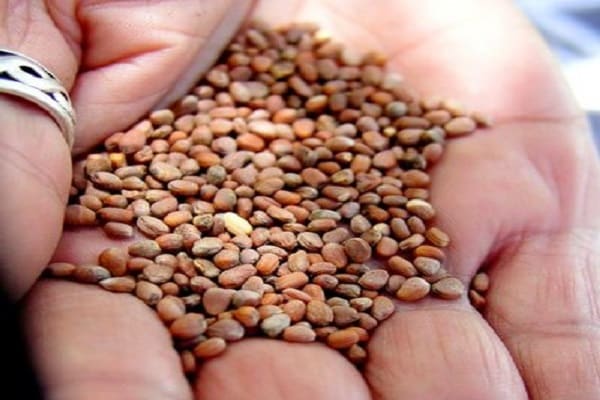
Growing seedlings from seeds
For spring planting, radish seedlings are obtained from seeds at home. To sow daikon seeds, use:
- peat pots up to 0.5 l;
- peat tablets;
- plastic containers with a depth of at least 10 cm.
The soil (neutral, slightly alkaline) can be used both from the garden and purchased for seedling vegetables. The seeding depth is 2 cm. Several seeds are sown into the pots at the same time, after the first shoots appear, the weak ones are removed. In phase 4 true leaves, the seedlings are planted in the ground.
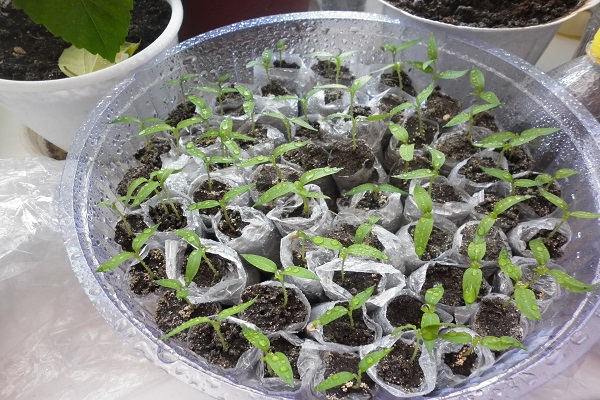
Landing dates
If the planting time is not followed, the daikon shoots and does not form a full-fledged root crop. For normal development, this plant needs no more than 12 hours of daylight and a temperature within 20 ° C. In heat and with prolonged daylight hours, the root crop stops developing, the plant releases an arrow and blooms.
To get a good harvest, you need to understand exactly when the daikon to plant seeds, when to seedlings, and when to refrain from planting.
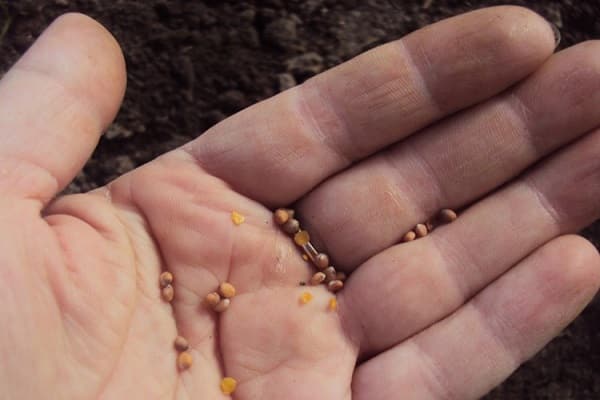
Using different planting methods (seeds, seedlings), daikon vegetable growers with different ripening periods are planted in different periods (spring, summer, autumn). For the middle zone and Siberian regions, the right time for planting comes in July (from 1 to 15) or in the last days of June, in the south it is the first days of August.
You can plant a daikon before winter and at the very beginning of spring. Daikon seeds do not freeze, they germinate if the soil warms up to 3 ° C. In the spring, you need to sow very early, as soon as the snow melts, and only early ripening varieties. At the end of April, do not waste time sowing daikon, the roots will not have time to form before the onset of hot weather.
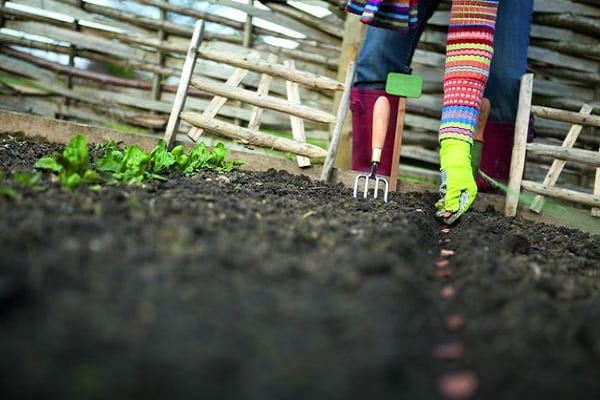
When to plant before winter
Gardeners have mastered the technology of sowing seeds before winter in order to obtain an early harvest of daikon in the spring using a seedless method. Disembarkation should be carried out after stable low temperatures have been established. In the fall, the seeds should not germinate.
The garden bed is prepared while the weather is warm. Humus or soil for pouring into the furrows is poured into any container and stored in a room with a positive temperature. Planting furrows are marked on the dug up and formed ridge.
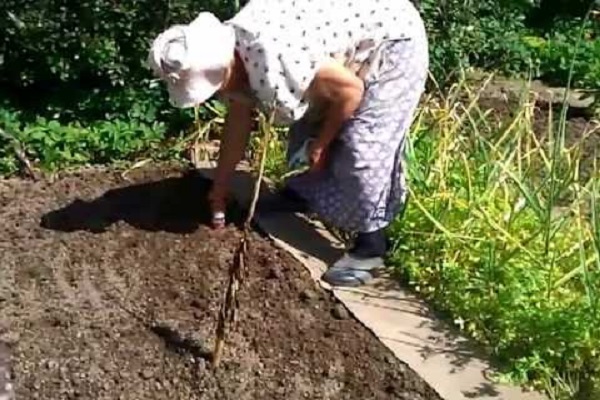
Seed consumption for autumn sowing is double, sowing thicker. Furrows are covered with harvested soil mixture. The entire surface of the garden bed is mulched with a thick layer of peat or humus. In winter, they throw snow on it if it is not enough.
Mulch is removed with the onset of warm days, after the land is completely free of snow. To speed up the germination of seeds, cover the bed with a transparent film. As soon as shoots appear, they raise it to arcs.

Care
Daikon is an unpretentious plant, but you need to know certain care features. List of main activities:
- watering;
- weeding;
- loosening;
- top dressing;
- disease control and prevention.
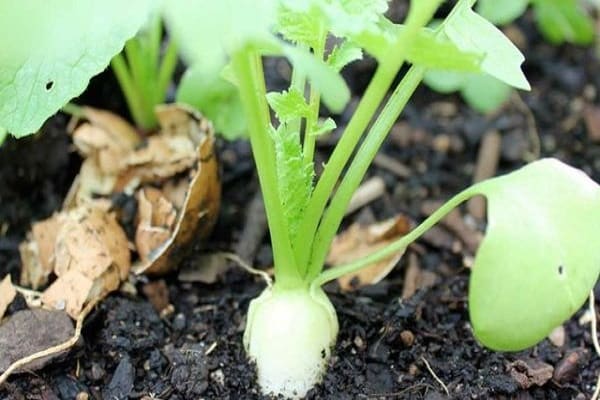
Watering schedule
Daikon is a moisture-loving plant.It is necessary to strictly adhere to the watering schedule in order to grow large root crops with delicate pulp. Pouring radish is not worth it, it is enough to maintain constant soil moisture. The standard watering schedule for cool weather is once every 5 days. In the heat, you need to water more often.
To save water and preserve moisture in the soil, gardeners mulch ridges with daikon with any available materials (dry grass, chopped bark, straw). Under a layer of mulch, the earth retains moisture longer, does not become crusty. In the absence of mulch, the aisles must be loosened after each watering.

Weeding
During the planting season, the radish is weeded 2-3 times. We need deep weeding. In addition to removing weeds, they loosen the soil. With a good supply of oxygen to the root crop, it grows to a large size. Seedlings are thinned several times, removing weak shoots and leaving the required distance of 30-40 cm between the shoots. The interval depends on the variety, large-fruited species need a large area for development.
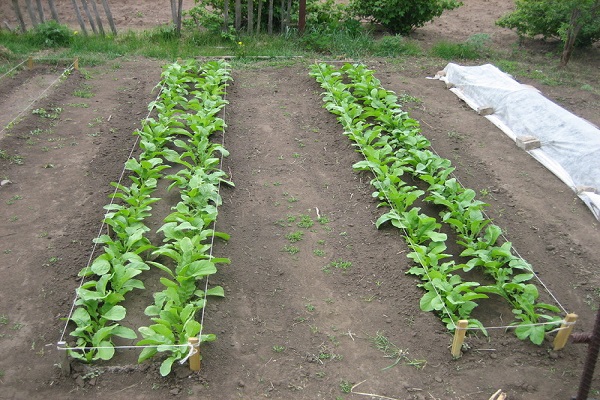
Top dressing and fertilization
On fertile soil, well fertilized with organic matter and mineral fertilizers, large fruits can be grown without additional fertilizing. If the soil is poor, then ash is used for feeding, adding a small amount of mineral fertilizers to it. For the first time, ash is introduced into the soil when 3 leaves are formed in a radish. With a slow formation of root crops, the procedure is repeated after 3 weeks.
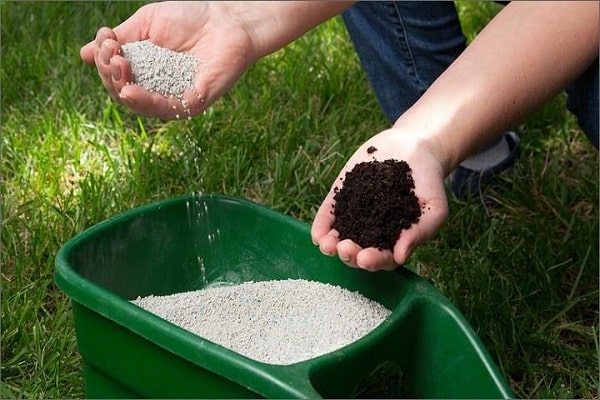
Diseases and pests
If the rules of agricultural technology are violated, the culture is affected by diseases. Constant waterlogging of the soil provokes a viral disease - bacteriosis. It is of two types: vascular, mucous.
Presowing seed treatment - prevention of all cruciferous diseases. Experienced farmers are advised to use the biological product "Planriz". It can be used for disinfection of seeds and subsequent treatments of plants from diseases.
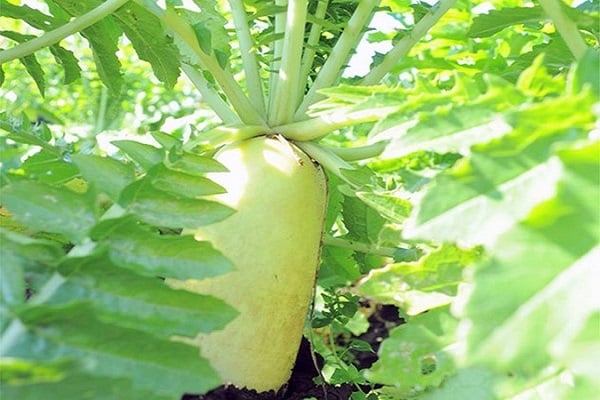
Harvesting and storage
Harvesting a good harvest of large root crops is a pleasure. Fruits grown on light soils can be pulled out by the tops. For harvesting root crops growing in dense, heavy soil, you will need a pitchfork to dig in the ground.
Cleaning is done when dry weather sets in. Root crops with mechanical damage, eaten by pests, with signs of rot are discarded, and high-quality fruits are sent for storage, after drying and cutting off the tops.
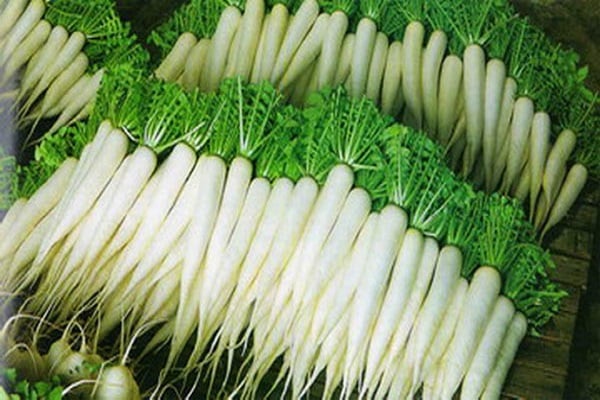
Daikon radish varieties
A description of the daikon, several of its popular varieties, varieties for the middle lane will help you make the right choice. You should not delay with it, because the time is right for planting Japanese radish.
When choosing a variety, take into account the ripening period, how long can it be stored? For winter consumption, you need to select varieties that are stored for up to six months. For fresh consumption in the summer-autumn season, early ripening varieties of daikon are suitable.
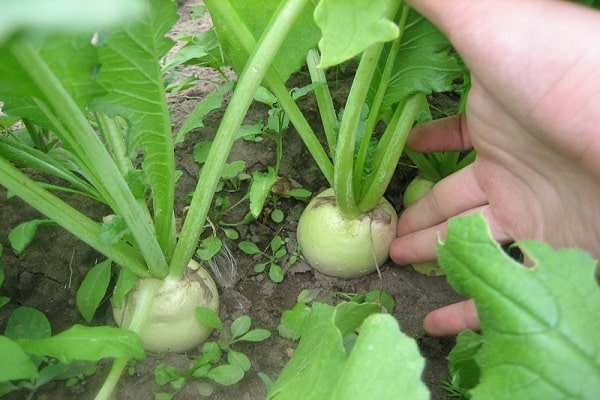
Sasha is an interesting, early maturing daikon variety. The growing season is short - from 35 to 45 days. It is a round root vegetable with white skin and flesh. The weight of the fruits does not exceed 400 g. Depending on the growing conditions, the weight can vary from 200 to 400 g. The diameter of the radish is about 10 cm; during growth, most of the fruit is above the soil surface.
Lovers of cylindrical fruits can be recommended the elephant tusk variety. This daikon is mid-season. It takes just over 80 days to form a root crop weighing 500-600 g. The vegetable reaches a length of 18-25 cm, with a diameter of about 8 cm. This variety is good because it tolerates drought and guarantees a stable harvest.
Growing a daikon is not a tedious task. Do-it-yourself root vegetables will add variety to the diet and benefit your health.
